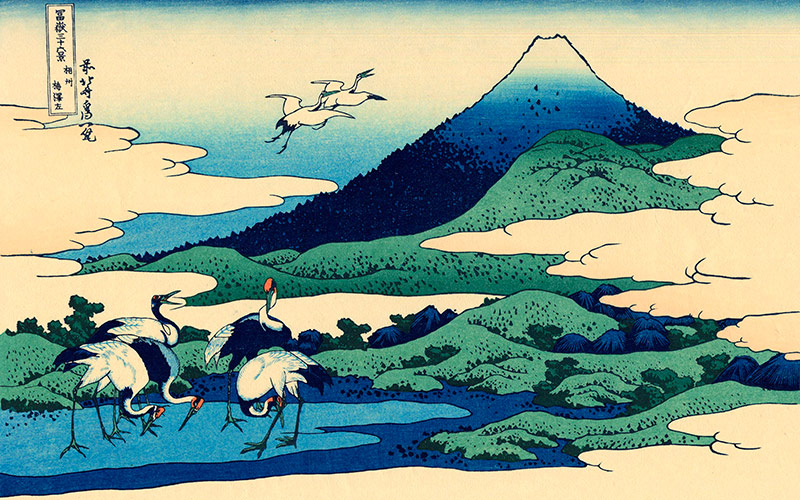About the Game
The Haiku is a Japanese form of poetry that came into being in the 17th century. Its formal limitations are very strict. Three lines, 5-7-5 syllables. Traditionally the subject of a haiku is nature, the seasons. A haiku evokes an experience in the here-and-now. Its directness can bring about a moment of enlightenment.
The game is a fusion of oral tradition: learning texts by heart in order to really become one with them; a western traditional game and a Japanese poetic style.
Playing the game allows groups of people or families to work with ‘human awareness of time and place in the presence of nature’. While playing, people can deepen their understanding of the philosophical ideas behind it. It is a fun way to be together and think.

I started writing haiku during my journey through Japan. My Haiku are written for the people of the 21st century. Our nature is our body and mind. But many of us are losing bodily contact with nature. The urban environment has become the natural habitat for at least two thirds of the world population. This affects us in how we can connect to nature and how we experience ourselves. Is it still possible to feel we are parts of a living cosmos? I believe we must find new roads to the inner worlds which lay hidden under the brick and cement of our urban existence. I hope playing the Haiku Quartet game will contribute to that.
How to Play
The game is played like a traditional game of Quartets. Each player tries to collect sets of four cards, a Quartet. If a player is able to cite the Haiku that he needs, the other players are held to give it to him. The one who gathers the most Quartets, wins.
A Quartet consists of four Haiku dealing with a certain philosophical theme. In the game there are 13 sets, entitled:
| Enlightenment | The Way | Birds |
| Tenderness | Place and Space | Woman – Man |
| Nature | Experiences | Capital |
| Creators | Tokyo | Japan |
| Family |
Haiku Cards
In Seventeen syllables
Within the three lines.
~
23. Accepting the way:
24. My mother died twice
26. Reaching enlightenment
'Illumination' suggests that a haiku harbors an insight that touches our heart and may evoke compassion or laughter. A haiku is 'here-and-now'.
Or Cleaning Namda station:
How many mirrors!
~
3. My mind emptied
8. Tasting tempura
9. White sand - fifteen rocks
The first lesson is to clean ourselves. Physical cleaning precedes the mental one. Mental cleaning aims to empty the mind of its obsessive and endless thoughts. Meditation helps to face the restlessness of mind and heart by attentive breathing, again and again.
Cleaning Osaka's Namda station is a simple task compared to cleaning the many mirrors of my mind, through which i imagine to perceive reality. What i really see are usually images of myself, in stead of the all-pervading Reality.
By the sound of one cricket
How easy is life.
~
2. Emptying my mind
8. Tasting tempura
9. White sand - fifteen rocks
With Buddha as the driver:
No cleaning needed.
~
32. Pacific Ocean
33. Pacific Ocean
36. Time space of email
How to describe my amazement at the sight of him as Buddha in the National Museum of Nara. There was no difference between him and the statue. Buddha-hood is everywhere... no cleaning needed.
Just the cry and laughing of
Yaro and Hazel.
~
50. The eyes of Ezra
47. No better horse for
56. I leave Osaka
Grandson Yaro of my consort Colette and my granddaughter Hazel were born a few months before the journey, which was my family's gift to me with only one string attached: to stay for a while in a Buddhist temple. During the early morning ceremonies of the monks and nuns, the realization crossed my mind that the simultaneous cry and laughing of Yaro and Hazel are the gateways to satori.
Of the old crippled lady
Serving us cold tea.
~
10. Couples in moonlight
30. The sound of the bell
35. Love letter written
When there is tenderness in the heart, there is tenderness outside the heart.
Serving cold tea refers to the warm season.
Serving hot tea refers to the cold season.
Everything proves to be interrelated.
The gate to nature's belly
Full of surprises.
~
2. My mind emptied
3. Emptying my mind
9. White sand - fifteen rocks
Our belly is nature - always present.
Infinite concentration!
Too much to swallow.
~
2. My mind emptied
3. Emptying my mind
8. Tasting tempura
Beauty beyond reach belongs to the sublime for which there are no words.
Bjørn Aris, one of Europe's great sword masters, commented upon my position at the back of the Card Game.
I enjoyed his remarks manifesting the mind of the swordsman, and answered: there are two reasons for this position. First of all, I am not longing for perfection, only for near-perfection, in order not to think about perfection; and second: writing a haiku requires a natural position of the body.
Then we laughed and listened to the sound of the North sea inside the glasspavilion of the Kurhaus in Scheveningen.
Lining the Ramo river
Gently passing by.
~
7. How tender the look
30. The sound of the bell
35. Love letter written
Black white blue red yellow green
Where go the arrows?
~
22. Clock time reigns the world
43. Money has a will
49. The dollar-framed mind
Flying above hills and lakes
Enjoying my self.
~
13. Migratory birds
14. The heron descends
15. Heron in Warder
Moving straight ahead, unmoved
Gazing from above.
~
12. Becoming a bird
14. The heron descends
15. Heron in warder
Watching motionless her prey
Unconscious of fate.
~
12. Becoming a bird
13. Migratory birds
15. Heron in Warder
Same heron in Kyoto:
Who knows about whom.
~
12. Becoming a bird
13. Migratory birds
14. The heron descends
His face is mysterious
She yet unknowing.
~
17. The woman looks at him
18. The woman and man
44. Two masks one actor:
Her face is open-minded
Seduction stand by.
~
16. The man looks at her
18. The woman and man
44. Two masks one actor:
Are suddenly perceiving:
Nothing stands between!
~
16. The man looks at her
17. The woman looks at him
44. Two masks one actor:
In the mountains of Awa:
Energy exchange.
~
21. Without time in mind
34. The floor of Ando
27. Japanese I feel
Of crickets in the evening
Dark nature awakes.
~
25. Tall in the blue sky
31. Breathing red blood cells
51. Whatever exists
One never misses the train
How liberating!
~
19. My beard grows faster
34. The floor of Ando
27. Japanese I feel
Fetching the mind of humans-
Dogs and cats more free.
~
11. Capital feels too:
43. Money has a will
49. The dollar-framed mind
It is and is not and both
And not both, It is!
~
1. Reaching enlightenment
24. My mother died twice
26. Reaching enlightenment
Once and tonight in my dream:
She’s alive in me.
~
1. Reaching enlightenment
23. Accepting the way:
26. Reaching enlightenment
The wooden cabin on poles
Small when the rain falls.
~
20. How intense the sound
31. Breathing red blood cells
51. Whatever exists
Equals the natural way
Nature likes to hide.
~
1. Reaching enlightenment
23. Accepting the way:
24. My mother died twice
Becoming a river fish
To be eaten raw.
~
19. My beard grows faster
21. Without time in mind
34. The floor of Ando
«Deus sive Natura»
Japan Spinoza.
~
37. Japan one country
55. Nippon Netherlands
54. Emperor Empress
Early morning, is touching
My heart and belly.
~
7. How tender the look
10. Couples in moonlight
35. Love letter written
Up the brain and down the spine
The snake awakens.
~
20. How intense the sound
25. Tall in the blue sky
51. Whatever exists
No master no slave or god
A boundless spirit.
~
5. Leaving Koyasan
33. Pacific Ocean
36. Time space of email
Only the sky can bridge it
But fish feel at home.
~
5. Leaving Koyasan
32. Pacific Ocean
36. Time space of email
Tells stories about his guests
Their way of moving.
~
19. My beard grows faster
21. Without time in mind
27. Japanese I feel
With black ink on soft paper
The touch of her skin.
~
7. How tender the look
10. Couples in moonlight
30. The sound of the bell
Space time of writing by hand
Feel the difference!
~
5. Leaving Koyasan
32. Pacific Ocean
33. Pacific Ocean
Where my nails stay clean for weeks
How astonishing!
~
29. «Nature Deity»
55. Nippon Netherlands
54. Emperor Empress
Projecting yin yang movements
Mastering Dior.
~
39. Birds flowers snakes girls
40. Conscious animal
53. Tange's Notre Dame
Black gold blue green orange and red:
Issey Miyake.
~
38. M V R D V
40. Conscious animal
53. Tange's Notre Dame
The attraction of leather:
Dolce Gabbana.
~
38. M V R D V
39. Birds flowers snakes girls
53. Tange's Notre Dame
Standing quietly alone
People rushing by.
~
42. Shops shops shops hops shops
52. Daily seeing so
48. The crooked old man
Shops shops shops monk shops shops shops
Shops shops shops shops shops.
~
41. Monk at crossing point
52. Daily seeing so
48. The crooked old man
Of its own, and in its way
Peace and war on hand.
~
11. Capital feels too:
22. Clock time reigns the world
49. The dollar-framed mind
Woman and man alternate
Before being born.
~
16. The man looks at her
17. The woman looks at him
18. The woman and man
Riding than your own father
Hit and hold the reins.
~
6. God, Gods nor Buddha's
50. The eyes of Ezra
56. I leave Osaka
Kept running along track one
While the train had left.
~
41. Monk at crossing point
42. Shops shops shops shops shops
52. Daily seeing so
Keeps running after money
Its eyes myopic.
~
11. Capital feels too:
22. Clock time reigns the world
43. Money has a will
Mirrors of sun on the moon
How enlightening!
~
6. God, Gods nor Buddha's
47. No better horse for
56. I leave Osaka
Loves something else in nature
Except capital.
~
20. How intense the sound
25. Tall in the blue sky
31. Breathing red blood cells
Many - never again nor
In the afterlife.
~
41. Monk at crossing point
42. Shops shops shops shops shops
48. The crooked old man
Designed as Buddhist Temple
With Sienese Forum.
~
38. M V R D V
39. Birds flowers snakes girls
40. Conscious animal
Skyscrapers guard their palace:
Japan’s two faces!
~
29. «Nature Deity»
37. Japan one country
55. Nippon Netherlands
No sunrise without sunset
This circle is round.
~
29. «Nature Deity»
37. Japan one country
54. Emperor Empress
Without Buddha as driver
Bringing haikus home.
~
6. God, Gods nor Buddha's
50. The eyes of Ezra
47. No better horse for

